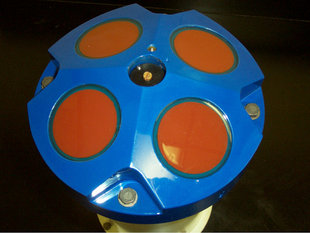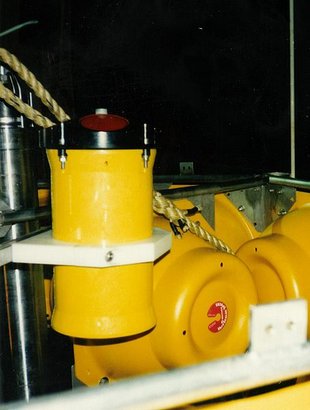Acoustic Doppler Current Profiler
An Acoustic Doppler Current Profiler (ADCP) is an instrument used to measure ocean (Seas of the world) currents. It transmits high frequency acoustic signals which are backscattered from plankton, suspended sediment, and bubbles, all of which are assumed to be traveling with the mean speed of the water. The ADCP estimates horizontal and vertical velocity as a function of depth by using the Doppler effect to measure the radial relative velocity between the instrument and scatterers in the ocean. Used in numerous marine and oceanographic studies, ADCP devices may also produce adverse consequences of underwater noise pollution, which may interfere with cetacean navigation and ecolocation.
Contents
Operating principles
Three acoustic beams in different directions are the minimum number required for measuring the three velocity components, with a fourth adding redundancy and an error estimate. A ping is transmitted from each transducer about once per second, with the echo returning over an extended period. Echos from shallow depths return before those from greater depths. Profiles are produced by range–gating the echo signal, i.e. breaking the echo into successive segments called depth bins corresponding to successively deeper depth ranges. The noisy velocity estimates from each ping are vector–averaged into one to ten–minute ensembles, and the resulting relative velocities are rotated from the transducer’s to the Earth’s reference frame using the ship’s gyrocompass.
A navigation calculation is performed to obtain absolute current velocity vectors, which are obtained by subtracting the average of the ship velocity relative to a reference layer (i.e. ADCP velocities) from the absolute ship velocity over the ground (from GPS navigation). The raw absolute current velocities relative to the reference layer are then smoothed to reduce the effect of noise in the position fixes, and combined with the navigation data to obtain the best estimates of ship positions and velocities. Thus, absolute currents at any depth can be determined from the ship navigation data and the relative ADCP measurements.
The ADCP measures the ocean current velocity continuously over the upper 300 meters (m) of the water column, usually in eight m depth increments. It is also used to estimate the abundance and distribution of biological scatterers over the same depth range and in the same depth increments.
ADCP data collection requires that four instruments work together. These are the ADCP itself, the ship’s gyrocompass, a GPS receiver, and a GPS Attitude Determination Unit
Configurations
ADCPs can be configured in many ways: (a) Side-listening, into rivers and canals for long term continuous discharge measurementsp (b) Downward-listening, boat-mounted devices for instantaneous surveys in a sea or river; (c) Mooring mounted assemblies, or the Seabed for long term current and wave studies.
Based upon the nature of the field application, an ADCP can employ various ceramics, (or other piezo-electric materials) for transducers, which function underwater much like directional loudspeakers in air. These transducers are pointed in a manner that causes sound rays to propagate through the water in different vector directions. As the sound energy leaves and arrives at the transducer face it is shifted in frequency, known as the Doppler effect, by the relative velocity of the water. As that sound energy is reflected by scattering points, acoustic energy may also be shifted in frequency if there is relative velocity of water to scatterer. Trigonometry, averaging and some critical assumptions are used to compute the velocity of the group of echoic scatters in a water mass. By repetitive sampling of the return echo, and by gating the return data in a temporal train, the ADCP can create a picture of water currents through a range of depths. Phased array techniques are also used to aim the acoustic energy, permitting economical production of smaller ADCPs to handle a range of frequencies from 38 kHz to several megahertz.
In addition to the transducers, an ADCP characteristically contains an electronic amplifier, receiver, mixer, oscillator, precision clock, temperature sensor, compass, pitch and roll sensor, analog-to-digital converters, memory, digital signal processor and instruction set. The analog-to-digital converters (ADCs) and digital signal processor (DSP) are used to sample the returning signal, determine the Doppler shift, and sample the compass and other sensors in order to calculate range and a velocity vector relative to a known orientation.
Accuracy issues
There are a number of factors that affect accuracy, resolution and profile range. Most notable are: absorption, spreading, velocity of sound in water, bandwidth of the sound energy, signal strength of the transmitted pulse and echo, size of transducer, frequency, and a number of constraints associated with the signal processing techniques and hardware, including clock/oscillator accuracy.
Applications
ADCP technology, commercially available since about 1980, is currently used for oceanography, estuary, river and stream flow measurement, even in weather forecasting. ADCPs are used in diverse ways, from locating underwater gyres that could harm deep water oil drilling equipment, to measuring water flow through sewer pipes, or appended beneath an iceberg to measure the flow of freshwater melt flow. Some harbor managers utilize ADCP technology to take advantage of tides and currents and optimize the flow of shipping in an active port.
An ADCP may be sustained by batteries for many years under the sea or remotely in a riverine system. Some time later they are retrieved and the historical current data is transferred from the ADCP memory to a computer and displayed using a variety of graphical and text-based software to observe the water current profiles.
Doppler velocity log device
An ADCP can also be an acoustic Doppler Velocity Log (DVL) when programmed with appropriate signal processing logic. A DVL reflects from the deepest water layer (or other intermediate layer) in order to reckon the velocity vector of a vessel moving near the sea floor. This information can be combined with a starting fix, compass heading, and acceleration sensors (typically by use of a Kalman filter) to calculate the position of the vehicle. DVLs can be appliee to assist in navigating a surface vessel or submarine for precise positioning in an environment where GPS, and other navigational aids, are not able to function.
Further Reading
- Physical Oceanography Index
- Joint Archive for Shipboard ADCP

